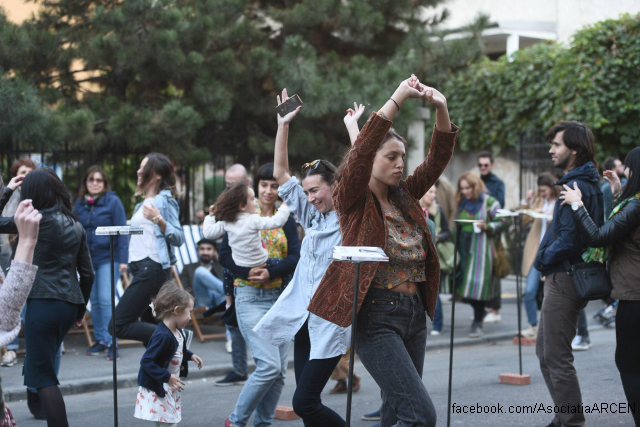Leseempfehlungen, Bücherpyramiden auf der Straße, Lesungen zeitgenössischer Poesie und organisierte Stadtführungen, kulinarische Delikatessen, zubereitet vom Meisterkoch Liviu Lambrino für eine gemeinsame Mahlzeit (ein langer Tisch, aufgedeckt für etwa 30 Personen) — das alles erwartet die Einwohner von Bukarest im Oktober in der Innenstadt. Außerdem lädt Paul Dunca die Bukarester zum Tanzen ein, zur Musik von Jim Felix. Die Open-Air-Filmprojektionen ziehen ebenfalls viele Besucher in die Innenstadt der rumänischen Hauptstadt an.
Edmund Niculuşcă ist der Leiter des Rumänischen Kulturvereins Bildung und Normalität“, kurz ARCEN, und zugleich Urheber der Veranstaltung. Er lieferte uns folgende Einzelheiten zum Event:
Wir verwandeln die Straße in einen vielschichtigen Raum. Innerhalb von 12 Stunden sollen ganz viele Veranstaltungen in der Straße I.L. Caragiale stattfinden: Es kommt die Ausstellung, die Rumänien an der Internationalen Architektur-Biennale in Venedig vertreten hat, Mnemonix, »În faţa blocului« (»Vor dem Wohnblock«), das Projekt, das alle Kindheitsspiele in einem Buch vereinigt. Block Party, unsere Veranstaltung, umfasst einige Schlüsselmomente: das Spiel, den Tanz, den Dialog.“
Liegestühle, Teppiche, Sitzpolster, Decken, Bücherregale — das alles gab es in der Innenstadt am Wochenende. Die Besucher hatten die Gelegenheit, ein freundliches Wohnzimmer direkt in der Straße zu genießen. Eine Buch-Installation lädt direkt vor Ort zum Lesen ein. Eine an einem Ziegelstein befestigte Metallstange mit einer Platte am Ende, worauf das Buch stand — so sah die Buch-Installation aus. Sobald ein Leser das Buch von der Platte hob, fand er darunter einen Zettel, mit der Begründung der Buchempfehlung. Edmund Niculuşcă erzählte uns mehr über die Projektentstehung:
Bukarest braucht ein neues historisches Kulturzentrum. Die Umgebung von Icoanei ist der richtige Ort dafür. Icoanei ist ein historischer Stadtteil und liegt im Zentrum von Bukarest. Sein kulturelles Potenzial kann genutzt werden. Icoanei kann sich zu einem anderen historischen Zentrum entwickeln.“
Die Geschichte hat in diesem Stadtteil eine kulturelle Dimension. Sie lässt sich gerne enthüllen, so Edmund Niculuşcă:
In der Straße I.L. Caragiale befinden sich alle Partner von District 40: das Französische Institut, die Zentralschule, die Residenz Scena 9, Point, die Buchhandlung Cărtureşti und Cinetics. Es sind sechs Partner, die bereits an diesem Netz — District 40 — teilnehmen. Während der Museennacht fanden verschiedene Veranstaltungen in ihren Räumlichkeiten statt. Nun vereinigen sich all diese Kulturinstitutionen und begegnen einander in einer Straße. Sie beweisen, dass es möglich ist, zusammenzuarbeiten und das Unmögliche möglich zu machen. Ursprünglich hatten wir das Projekt als »Stadtteil im Zentrum« bezeichnet, bevor wir auf den Namen »District 40« kamen. Wir wollten nämlich ein verschiedenartiges Stadtzentrum schaffen. Die Philosophie, die dem Projekt zugrunde steht, haben wir bewahrt, auch wenn sich der Name geändert hat.“
An den Straßenveranstaltungen nahm auch die Dichterin Nora Iuga teil. Sie las aus ihrer Poesie vor. Anwesend waren auch Vertreter verschiedener Urbanismusprojekte, unter anderem der Kurator des Projekts MNEMONICS sowie die Architekten Şerban Sturdza und Şerban Radu. Letzterer ist übrigens der Begründer der Buchhandlung Cărtureşti. Debattiert wurde auch über das Projekt Catalog 40. Das Vorhaben zielte darauf ab, die Menschen mit den geschützten Gebieten in Bukarest vertraut zu machen. Alberto Groşescu, stellvertretender Vorsitzender des rumänischen Kulturvereins ARCEN, mit mehr Einzelheiten:
Von allen ARCEN-Projekten, die wir bislang umsetzten, war dieses das dynamischste. Es erfuhr die meisten Änderungen. 2015 haben wir zwei weitere bebaute geschützte Gebiete identifiziert. Das war unsere Demo-Version. Bei dieser Gelegenheit stellten wir die Dynamik der Stadt fest. Wir beobachteten, wie schnell sich die Stadt weiterentwickelt. Daher überlegten wir, wie wir die Schutzgebiete innerhalb der Stadt bewahren können: Wir schauten, was noch zu retten war. 2017 fingen wir mit der Datenerfassung an. Das zentrale Stadtviertel Icoanei kam schnell dran. Doch damals wussten wir nicht, das es zur Umsetzung des Projekts District 40 kommen würde.“
Wir schlichen uns zwischen den Gästen, um von ihnen zu erfahren, was sie von der Block Party hielten. Wir trafen Dana, eine 43-jährige Frau, die in Begleitung ihres Sohns war. Warum sie an der Veranstaltung teilnehme, wollten wir von ihr erfahren:
Ich las im Internet darüber und wollte schauen, was hier vor sich geht. Ich fand hier Leute wie ich, Bücher, einen ruhigen Ort, wie es kaum in Bukarest gibt. Leute, die uns ähnlich sind, die die Ruhe lieben, gerne lesen und sich eine Stadt wünschen, wie sie hier zu erleben ist.“
Radu, Danas Sohn, ist 13 Jahre alt. Er sagte uns auch, warum er zur Block Party kam:
Ich war neugierig, was hier los ist. Es ist eine angenehme Freizeitalternative für einen Sonntag. Da kann man sich entspannen, ein Buch lesen, sich auf einem Liegestuhl ausruhen. Ich glaube, meine Schulkommilitonen würden so etwas nicht unbedingt zu schätzen wissen!“
Beide Abende gingen im Tanzschritt zu Ende. Von den existenziellen Fragen, die zur Musik gestellt wurden, ist bei mir eine hängen geblieben: Wie lange willst du leben? Stimmt es, dass du mit der Zeit das Älterwerden anders wahrnimmst?“ Ein Thema zum Überlegen!
